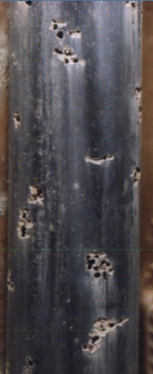Fast Dissolution of Precious Metal Anodes (PMx)
Product Support and Customer Service
For Further support visit our Contact Page
Safety
Think and act in a safe manner. Always disconnect power and use a lockout before you work on the E-coat system, or any of the related subsystems. Observe any confined space conditions. Use the appropriate safety equipment and clothing for the task. Please carefully read all the instructions listed below to familiarize yourself with the project before attempting to perform any of the work.
Required Materials
- Anolyte Anti-corrosive Additive
- UFS Service Reference 990127 (Parameter Values Recording Form)
- UFS Service Reference 990161 (PMx Inspection)
Required Tools
- Portable “X-ray Machine” for evaluating PMx coating for 10x scope if necessary
General
Generally an issue only seen with Cathodic E-systems, the rapid dissolution of the PMx (precious metal type) anodes comes as a surprise. What is fast dissolution of PMx? Once the PMx coating has lost about 30% of it’s original coating, the anode (Titanium) surface is at risk for developing pits (Figure 1) and you should think about replacing them. The pits generally start low on the anode on the side facing the ware. In some cases the pits then migrate around the bottom of the anode, or in other cases the pits migrate up the face of the anode on the side closest to the ware. Typically, these PMx operate ideally when used in white/light cathodic paint at a current density of 3-5 Amps/square foot of anode area. Note: Precious Metals coated Titanium anodes are used only in a Cathodic E-Coat System. They are not to be used as a cathode. The PMx sold at UFS is a mixed metal oxide catalyst coated on a titanium substrate. The PMx is used as a high current density oxygen-evolving anode, which is more dimensionally (i.e. less soluble, or sacrificial) stable during operation than 316L stainless steel. It is most often used with white or light colored Cathodic paints that are sensitive to iron contamination. If local water discharge rules are severe, then PMx anodes will dissolve and typically release Ti and precious metal oxides into the anolyte solution.
Operating Factor Level of Concern Possible Effect to Anode Possible Effect to Anode 15 minutes every 3 days
Once every 3 hours
Once every minuteApproximately 25% loss of life.
Approximately 50% loss of life.
Approximately 90% loss of life.Temperature
60 - 80°C (pH <2)
5 - 90°C (pH 2-12)Approximately 50% loss of life.
No loss of life predicted.Alkaline Anolyte
> pH 12
Hot caustic may result in accelerated coating loss
Typical Failure Modes
Figure 1. shows how pits have penetrated through the Ti tube. Figure 2 shows light colored regions. Generally these light colored regions have a color close to ‘battle ship’ gray. The third failure mode is referred to as loss of adhesion (between the PMx oxide coating and the Ti tube). This is evident if you hold the tube and then look at your hand. If you see black material on your hand then this may be an issue. It is typical to see some amount on your hand, but the more that comes off indicates a failure is in progress. In some cases detailed examination using x-ray and other methods can be performed at no extra cost. Please contact customer service for information on this option. It is a very difficult task to identify the specific causes when a customer experiences fast dissolution of their Precious Metal coated Anodes. The following is a list of possible contributors to excessive corrosion of Precious Metal Anodes and the possible effects they may be having on Anodes:
Anolyte Component Level of Concern Possible Effect to Anode Fluoride 1 – 5 ppm Premature loss of coating due to attack of titanium substrate. Bomide 50 ppm Reduced titanium breakdown potential if electrode is deactivated. Bomide 50 ppm Reduced titanium breakdown potential if anode is deactivated. Cyanide 1 ppm Premature coating failure due to complexing of the precious metal in the coating Manganese 50 ppb Plating on anode surface causing localized high current densities and possible shorter coating life. Barium 1 ppm (sulfate anolytes Deposition of barium sulfate on anode surface will cause high localized current densities and higher anode voltages. Strontium 30 ppm (sulfate anolyte) Deposition of strontium sulfate will result in high current densities, high anode voltage, and possible shorter anode coating life. Organics 1 ppm EDTA causes coating loss (Figure 2) and premature coating failure. However, each organic must be addressed on a case-by-case basis. Some organics form a deposit on the anode coating which will result in increased voltage. There are several things that should be done: 1) Never allow city water (or other high conductivity water) into the E-coat paint system; and 2) Ask the E-coat paint supplier for their recommendation of an appropriate additive to reduce the chance of a high PMx dissolution problem. (UFS can help the E-coat paint supplier in this selection process.) 3) Be careful not to allow halides to enter the E-coat paint bath of the anolyte solution. These are sometimes used as active ingredients in fungicides and biocides.
Here are some other suggestions:
- Record the conductivity of the anolyte every day on a form that is included in UFS Service Reference #990127.
- Record both the E-coat Bath pH and the anolyte pH on above mentioned Service Reference #990127.
- Add the (recommended by the E-coat paint supplier and UFS) on a regular basis since the anolyte is always being turned over and lost as the conductivity controllers add fresh DI water.
- Begin a process of visually inspecting (with hand-held or portable 10x microscope) a sample of the PMx every six months or so. Graph this data and use it to predict when to replace your anodes (generally when you have less than 30% of the original coating mass left – as measured with an x-ray test instrument).
- Record a process by which you inspect the PMx for excessive corrosion. (Request UFS Bulletin #990161.)

